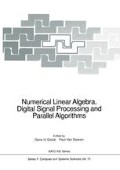Abstract
The Total Least Squares (TLS) method has been devised as a more global fitting technique than the ordinary least squares technique for solving overdetermined sets of linear equations AX ≈ B when errors occur in all data. If the errors on the measurements A and B are uncorrelated with zero mean and equal variance, TLS is able to compute a strongly consistent estimate of the true solution of the corresponding unperturbed set A 0 X = B 0. In this paper the TLS computations are generalized in order to maintain consistency of the solution in the following cases: first of all, some columns of A may be error-free and secondly, the errors on the remaining data may be correlated and not equally sized. Hereto, a numerically reliable Generalized TLS algorithm GTLS, based on the Generalized Singular Value Decomposition (GSVD), is developed. Additionally, the equivalence between the GTLS solution and alternative expressions of consistent estimators, described in literature, is proven. These relations allow to deduce the main statistical properties of the GTLS solution.
Access this chapter
Tax calculation will be finalised at checkout
Purchases are for personal use only
Preview
Unable to display preview. Download preview PDF.
References
R.J. Adcock. The Analyst 5 (1878), pp. 53–54.
M. Aoki and P.C. Yue. IEEE Trans. Autom. Contr. 15 (1970), pp. 541–548.
L.M. Ewerbring and F.T. Luk, Canonical Correlations and Generalized SVD: Applications and New Algorithms. Techn. Rep. EE-CEG-88–11,Cornell Univ.,Ithaca, NY, July 1988 (to appear in J. Comput. Appl. Math.).
K.V. Fernando and H. Nicholson. IEE Proc. D 132 (1985), pp. 30–36.
P.P. Gallo. Commun. Statist.-Theor. Meth. 11 (1982), pp. 973–983.
L.J. Gleser. Ann. Statist. 9 (1981), pp. 24–44.
G.H. Golub, A. Hoffman and G.W Stewart. Lin.Alg. and its Appl. 88/89 (1987), pp. 317–327.
G.H. Golub and C.F. Van Loan. SIAM J. Numer. Anal. 17 (1980), pp. 883–893.
G.H. Golub and C.F. Van Loan, Matrix Computations. The Johns Hopkins Univ. Press, Baltimore, Maryland, 1983.
R.P. Guidorzi. Automatica 11 (1975), pp. 361–374.
G. Kelly. Ann. Statist. 12 (1984), pp. 87–100.
U. Kotta. Proc. 5th IFAC Symp. on Identification and System Parameter Estimation, Darmstadt, FRG (1979), pp. 453–458.
J. Leuridan, D. De Vis, H. Van der Auweraer and F. Lembregts. Proc..nth Int. Modal Analysis Conf.,Los Angeles, Feb. 3–6 (1986), pp. 908918.
M.J. Levin. IEEE Trans. Autom. Contr. 9 (1964), pp. 229–235.
F.T. Luk. J. Parallel Distrib. Comput. 2 (1985), pp. 250–260.
C.C. Paige. SIAM J. Sci. Stat. Comput. 7 (1986), pp. 1126–1146.
K. Pearson. Philos.Mag. 2 (1901), pp. 559–572.
P. Stoica and T. Söderström. Int. J. Control 35 (1982), pp. 449–457.
S. Van Huffel, Analysis of the total least squares problem and its use in parameter estimation. Doct. Dissertation, Dept. Electr. Eng., K.U.Leuven, Belgium, June 1987.
S. Van Huffel and J. Vandewalle. J. Comput. and Applied Math. 21 (1988), pp. 333–341.
S. Van Huffel and J. Vandewalle. SIAM J. Matrix Anal. Appl. 9 (1988), pp. 360–372.
S. Van Huffel and J. Vandewalle, Analysis and properties of the generalized total least squares problem AX ti B when some or all columns in A are subject to error. Int. Rep.,K.U.Leuven, Dept. of Electr. Eng., Mar. 1988 (submitted to SIAM J. Matrix Anal. Appl.).
Author information
Authors and Affiliations
Editor information
Editors and Affiliations
Rights and permissions
Copyright information
© 1991 Springer-Verlag Berlin Heidelberg
About this paper
Cite this paper
Van Huffel, S. (1991). The Generalized Total Least Squares Problem : Formulation, Algorithm and Properties. In: Golub, G.H., Van Dooren, P. (eds) Numerical Linear Algebra, Digital Signal Processing and Parallel Algorithms. NATO ASI Series, vol 70. Springer, Berlin, Heidelberg. https://doi.org/10.1007/978-3-642-75536-1_54
Download citation
DOI: https://doi.org/10.1007/978-3-642-75536-1_54
Publisher Name: Springer, Berlin, Heidelberg
Print ISBN: 978-3-642-75538-5
Online ISBN: 978-3-642-75536-1
eBook Packages: Springer Book Archive

